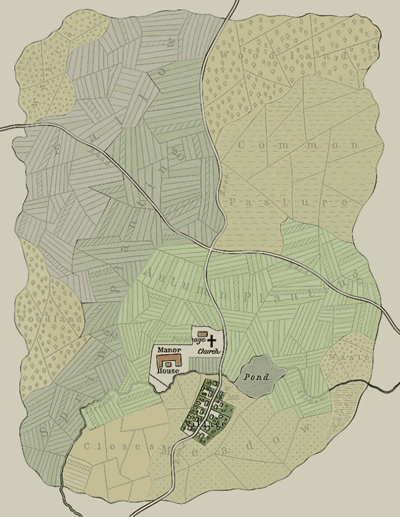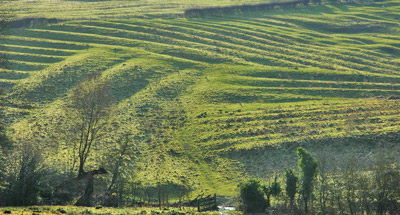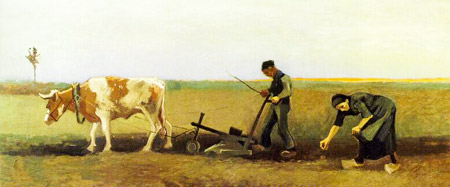Open Field System

Plan mediaeval manor 04

The method of ploughing the fields created a distinctive ridge
and furrow pattern in open-field agriculture. The outlines of the
medieval strips of cultivation, called selions, are still clearly visible today. 16
The map is a generic rendering of a medieval manor, showing strip farming. The mustard-colored areas are part of the demesne (Lord's land), the hatched areas are part of the glebe (other land). 05
The open field system was used in the early middle ages in much of Europe. The method of ploughing the fields created a distinctive ridge and furrow pattern in open-field agriculture. The outlines of the medieval strips of cultivation are still clearly visible in some present day fields in Europe. 06
Under the open-field system, each village had two or three large fields, usually several hundred acres each, which were divided into many narrow strips of land. The strips were cultivated by individuals or peasant families, often called tenants or serfs. 14th century open-field farming produced yields of 7 to 17 bushels per acre. 07
In Europe farming followed a set order. One field would be planted in the autumn with wheat, or rye durning the mini ice age because of the shorten growing season. A second field was planted in the spring with barley, oats, beans or peas. The third field was not planted. The field strips were about 40 rods long and one rod or less wide. 08
The introduction of rye in the sixth Century had an important stabilizing effect on Slav agricultural practice. Rye could be grown instead of barley and wheat every third year; we know that this happened, for instance, at the Slav fort of Tornow, south of Berlin. In the climatic conditions which prevail in the Baltic region, rye is indeed a more reliable crop than wheat, even though the preparation of the soil before sowing requires greater care. In other areas, Livland for example, slash-and-burn agriculture was only replaced by rye cultivation in about 1000. The use in some areas of the collar harness and the breast-strap harness made it possible to extend the use of horse traction considerably. The horse could now be used to pull the plough, as well as the heavy carts and sledges. As horses are more effective than oxen it was possible to cut down on work hours and above all to plough faster. Such an improvement was essential to increased production, especially in regions with Hght soils where large areas had to be tilled. The horse-drawn plough was almost twice as fast as the ox-drawn, as the chronicler Helmold among others teils us in relation to Slav agriculture in Mecklenburg. 03
Planting Potatoes Van Gogh-Kartoffelsetzen 09
Oxen used to do the ploughing were sometimes rather small, 600-900 lbs., compared to present day animals. The manors work came first, usually three to four days per week with the remaining time left for work on the serf's plot of land. 10
The open-field system was generally not practised in marginal agricultural areas or in hilly and mountainous regions. Open fields were well suited to the dense clay soils common in northwestern Europe.
Black Death in 1348-50 killed 30 to 60 percent of Europe's population. As a consequence the surviving population had access to larger tracts of empty farmland and wages increased due to a shortage of labour. Richer farmers began to acquire land and remove it from communal usage. The shift away from grain to livestock accelerated enclosure of fields. 11

